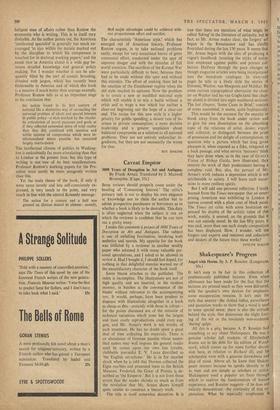Caveat Emptor
3000 Years of Deception in Art and Antiques. By Frank Arnau. Translated by J. Maxwell Brownjohn. (Cape, 35s.) BOOK reviews should properly come under the heading of 'Consuming Interest.' The critic's primary task is not to display his own elegance or knowledge nor to chide the author but to advise prospective purchasers or borrowers as to whether a book is likely to be desirable. This duty is often neglected when the subject is one on which the reviewer is confident that he can turn out a pretty essay. I make this comment a propos of 3000 Years of Deception in Art and Antiques. The subject is one of unfailing fascination, involving both aesthetics and morals. My appetite for the book was titillated by a reviewer in another weekly paper who adorned it with many valuable per- sonal speculations, and I asked to be allowed to review it. Had I bought it, I should feel duped, for nothing in that delightful exercise warned me of the unsatisfactory character of the book itself.
Some blame attaches to the publisher. The index is incomplete. The illustrations are not of high quality and arc inserted, in the modern manner, in batches at the convenience of the binder without relevance to the accompanying text. It would. perhaps, have been prudent to dispense with illustrations altogether in a book as cheap as this—certainly with those in colour— for the points discussed are of the minutiae of technical variations which none but the largest and most costly reproductions could even sug- gest, and Mr. Arnau's work is not worthy of such treatment. He has no doubt spent a great deal of time collecting his materials. There is an abundance of German pundits whose assem- bled names may well impress the general reader until he comes upon our own late lovable, clubbable journalist E. V. Lucas described as 'the English art-scholar.' He is in for another shock when he is told that Duveen collected the Elgin marbles and presented them to the British Museum. Frederick the Great of Prussia is de- scribed as 'the Emperor.' But it is not from these errors that the reader shrinks so much as from the revelation that Mr. Arnau shows himself quite unable to construct a literary work.
The title is itself somewhat deceptive. It is true that there arc mentions of what might be called 'faking' in the literature of antiquity, but in fact, as Mr. Arnau makes clear, the forgers' art began in the Renaissance and has chiefly flourished during the last 150 years. It seems that Mr. Arnau began with the idea of producing a rogue's handbook itemising the tricks of imita- tion employed against public and private col- lectors. Halfway through the pace changes as though magazine articles were being incorporated into the humdrum catalogue. In sixty-odd pages he tells in a lively style the stories of Dossena, Wacker, van Meegeren and Malskat. By some curious typographical aberration the chap- ter on Wacker and his van Goghs (and that chap- ter alone) is divided into eight numbered sections. The last chapter, 'Some Cases in Brief,' consists of notes assembled, it seems, quite haphazardly.
This would be the moment for the essayist to break away from the book under review and to give his own dissertation on the absorbing topic of the relations of artist, dealer, expert and collector, to distinguish between the pride of possession and the delight of contemplation, to question why a picture which has long given pleasure is, when exposed as a fake, relegated to a back passage, and what service 'restorers' think they have done when, as in the case of Giotto's Vision of Bishop Guido, here illustrated, they remove the work of their predecessors leaving a complete void. But, alas, the perusal of Mr. Arnau's work induces a depression which is not attributable to satiety. I will leave such excur- sions to more resilient spirits.
But I will add one personal reflection. I lately learned from the Times newspaper that an enter- prising American was exhibiting in London a canvas covered with a plain coat of black paint. The Times art critic with some hesitation ex- pressed his doubts of the artistic value of this work, mainly, it seemed, on the grounds that it was not entirely novel. In the last fifty years, it was said, more than one such simple composition has been displayed. How, I wonder, will the forgers and experts and restorers and collectors and dealers of the future treat these works?
EVELYN WAUGII






































 Previous page
Previous page